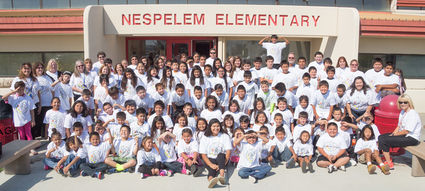PAX program bringing peace to school
Last updated 9/30/2015 at 10:09am

The students and staff at Nespelem Elementary School all display their PAX t-shirts Sept. 10. The shirts were designed by Rainy Dawn Thomas, who was an eighth-grader last year and now attends Lake Roosevelt High School. The design incorporates a traditional medicine wheel and a hand displaying a peace gesture. From left, in front row: Patricia Tatshama, Drake Sanchez, Cadence Clark, Kamrynn Orozco, Breanna Bird, Mercedes Fry, Cecilia Dick, designer Rainy Dawn Shihiya Vargas-Thomas, Nelly Selam, Nyla Yellowwolf, Audrina Reyes, Dredian Vallee, R'mya Lezard, Dasyn Epperson, Dakota Thomas, Sue Dickey. Row two: Jarvis Manuel, Adryanna St. Pierre, Nikolas Seymour, Cayse Quiltanenock, Talise Adolph, Norma Lowery, Lilliana Dick, Denise Simpson, Sadie LaClaire, Qwentana Quiltanenock, Majik Francis, Drake Weed, Kanyen Cate, Warren Circle, Zaedyn Desautel. Row three: Summer Lowery, Ruby Simpson, Carly Sanchez, Luke Yazzie, Edward Dick Mason, Saulque Rodger, Cate Hope Harris, Lola Yazzie, Taylor Thomas, Zyven Boyd, Kaiden Riggs. Row four: Principal Debra Pankey, Alexis Denchel-Bethel, Zoe Weed, Skyler Dogskin, Janie Epperson, Peyton Jake, Virgil Bearcub, Cylia St. Pierre, Mitchell Pakootas, mMixit Vargas-Thomas, Arianna Louie, Roscoe Owhi-Leach, Tito Michel, Nazaire Brisbois, Anoki Somday, Dennis George, Kyle LaClair, Jama Van Brunt. Row five: Linda Rise, Sheri Edwards, Elizabeth Corwine, Theresa Wilder, Camryn Carden, Shawnessy Bearcub, Yvonne St. Pierre, Scotti Adolph, Enid Bearcub, Anquan Adolph, Sidney Dick, Brandon Lowery. Row six: Debbie Bays, Tracy White, Dee Kuehne, Denise Hannahs, Candi Weed, Feather Fry, Kandace Leith, Marion Ives, Edward Cohen, Ayden Moore, Lisa Guzman-Elliot, Nathan Fulton, Moses Stanger, Kyle Edmo, Kyona Edmo, LoRinda Richardson, Marla Higgins, Shyniah Dogskin, Joshua Thomas, Harlen Dick, Soarin' Marchand, Charles (CJ) Saxon, Trevon Johnson, Tyrell Stanger, Isaiah Adolph, Zack Sellars, Samuel Simpson, Christina Christopherson, Kim Iverson, Terrance Saulque, Sherwin Vargas, Breezy Marchand, Ricardo, Adam George, Dean Erickson, Ricardo. - Scott Hunter photo
Kids at Nespelem Elementary know what a spleem is. It's what you're not supposed to do.
A pax, on the other hand, is what you are supposed to do.
Those two concepts, and those labels, are part of a new game at the school that is changing not just classrooms, but migrating into the larger community, too, some say. And it's giving students a new tool to help with school and life.
The PAX Good Behavior Game is making a difference in the school, helping kids learn how to behave appropriately and learn to focus on their own actions, rather than reacting to others. The word pax is Latin for peace.
Sidney Dick, a 13-year-old eighth-grader who has attended the school since kindergarten, said she now feels more comfortable, even safer, in the school that has been using the system since last spring. "It's improved our school," she said.
"PAX has made this school better and definitely more fun," agreed LoRinda Richardson, also an eighth-grader and student at the school since pre-school. And the kids are far nicer now, she said.
It's not magic, but it is a deceptively simple application of behavioral science, applied in a subtle and sophisticated way that helps kids learn to cue in on their own behavior and internalize it.
"All you have to do is say, 'I see a spleem,' and you just see them" thinking about what they might have done, said Principal Debra Pankey, who learned of the method at a conference last year. "When I heard it, it rang true for what we needed to bring here," she said.
A game and a reward lies at the heart of the method. Teachers set up teams of students and mark for and against the teams publicly during the game when she sees a good behavior (pax) or an unwanted one (a spleem). The winning team gets a reward in the form of brief activity, often one not normally allowed in school - shooting baskets with wads of paper, for instance. It can last seconds or minutes; the kids don't know how long it will last. But children actively remain focused on the teacher during the games, which become longer over time, increasing their attention spans and helping them form good habits.
The approach continues to be studied by scientists, and it has evolved and been improved since its core concepts were first introduced in the 1960s. The National Registry of Evidence-Based Programs and Practices, maintained by the U.S. Substance Abuse and Mental Health Services Administration, has published an independent review of the quality of scientific outcomes of the approach, reviewing dozens of studies.
And it may be spreading. Pankey recalled that a pre-schooler's mother last year reported the child had corrected her, "Mom, that's a spleem."
And staff from all Head Start programs at Nespelem, Inchelium, Keller and Omak attended a training session earlier this year.
"I think everybody likes it," commented eighth-grader C. J. Saxon, who noted he feels "sad" if he knows he was the one who just committed a spleem and let his team down.
And that's something he, and just about anybody else you know, will work to avoid.



Reader Comments(0)